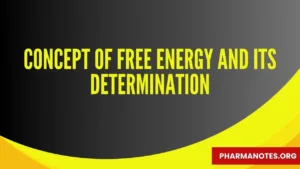The concept of free energy and its determination

Concept of free energy and its determination
Objective
At the end of this lecture, student will be able to
• Explain the concept of free energy and its determination
Bioenergetics
• Bioenergetics or biochemical thermodynamics deals with the study of energy changes (transfer and utilization) in biochemical reactions
• Reactions are broadly classified as exergonic (energy-releasing) and endergonic (energy-consuming)
• It is concerned with the initial and final states of the energy component of the reactants and not the mechanism of chemical reaction
• Free energy (∆G): Energy available to do work
• Reaction can occur spontaneously if they are accompanied by decrease in free energy
• Every chemical substance has a certain amount of energy built into it which is the energy of the chemical bonds holding the atoms together
• Synthetic reactions-energy utilized & breakdown reactions-energy released
• Exergonic reactions represent catabolic reactions
• Endergonic reactions represent anabolic reactions
• Enthalpy (∆H): is a measure of the overall amount of energy in the system or the sum of internal
the energy of a system
• It is positive in endothermic reactions and negative in exothermic reactions
• Entropy (∆S): represents a change in randomness or disorder of reactants and products
• It is the measure of disorder or randomness of a system
• Disordered system has high entropy and an ordered system has low energy
• Entropy attains maximum as the reaction approaches equilibrium
• First law of thermodynamics: The total energy of a system plus its surroundings remain constant
• Second law of thermodynamics: The total entropy of a system must increase if a process is to occur simultaneously
• Under constant temperature and pressure, the relationship between free energy change ∆G and change in entropy ∆S is given by combining the two laws of thermodynamics
• The relationship between the change of ∆G, ∆H & ∆S is expressed as
∆G= ∆H-T∆S
T= Absolute temperature in kelvin
(K= 273+ Co)
∆H = change in enthalpy or heat
• If ∆G is negative in sign, indicating loss of free energy (exergonic) and positive sign (endergonic reactions)
Negative and positive ∆G
• ∆ G is represented by a negative sign, there is a loss of free energy & reaction is said to be exergonic and proceeds spontaneously
• ∆ G is represented by a positive sign, indicates that energy must be supplied to the reactants & reaction cannot proceed spontaneously and is endergonic in character
• Exergonic reactions are termed catabolism (breakdown of molecules) and endergonic reactions as anabolism (synthetic reactions)
• Redox potential: In oxidation and reduction reactions, free energy exchange is proportionate to the tendency of reactants to donate or accept electrons
• Hydrolysis of ATP is a classical example of an exergonic reaction
ATP + H2O → ADP + Pi (∆ G = -7.3 Cal/mol)
• The reversal of the reaction (ADP + Pi → ATP) is endergonic and occurs only when there is a supply of energy of at least 7.3 Cal/mol (∆G is positive)
• The free energy change becomes zero (∆G = 0) when a reaction is at equilibrium
Applications of Free Energy in Biology
Free energy plays a crucial role in several biological processes, including:
- Cellular Respiration: The breakdown of glucose to produce ATP involves a series of biochemical reactions with negative Δ𝐺 values, indicating energy release.
- Photosynthesis: In photosynthetic organisms, light energy is converted into chemical energy stored in glucose molecules, with the overall process having a positive Δ𝐺 value.
- Active Transport: Many cellular transport processes, such as ion pumps, require energy input in the form of ATP hydrolysis to move substances against their concentration gradients.
Factors Affecting Free Energy
Temperature
Temperature plays a crucial role in determining free energy. As temperature increases, the entropy term (𝑇Δ𝑆) becomes more significant, influencing the overall change in free energy.
Pressure
Pressure affects free energy, especially in systems where volume changes occur. High pressure can favor reactions with smaller volumes, while low pressure can favor reactions with larger volumes.
Concentration
The concentration of reactants and products can impact free energy, particularly in chemical reactions. Changes in concentration can alter the Gibbs free energy change (Δ𝐺) and affect reaction spontaneity.
Concept of free energy and its determination Summary
- Bioenergetics deals with the study of energy changes in biochemical reactions
- Reactions are broadly classified as exergonic and endergonic
- The substances that possess sufficient free energy to liberate at least 7Cal/mol at pH 7 are called high
energy molecules - Free energy (∆G): energy available to do work
- Enthalpy (∆H), the measure of the change in the heat content of the reactant, compared to products
- Entropy (∆S), represents a change in randomness or disorder of reactions and products
Concept of free energy and its determination Unique FAQs:
- How is free energy related to ATP?
- ATP (adenosine triphosphate) serves as a carrier of free energy in biological systems. The hydrolysis of ATP releases free energy that can be used to drive cellular processes.
- Why is the concept of free energy important in biology?
- Understanding free energy helps biologists predict the direction and spontaneity of biochemical reactions, providing insights into the energetics of cellular processes.
- What is the role of enzymes in free energy changes?
- Enzymes catalyze biochemical reactions by lowering the activation energy, thereby influencing the rate of reaction without altering the free energy change (Δ𝐺).
- Can free energy be stored in biological systems?
- Free energy is stored in the form of high-energy molecules such as ATP, which serve as immediate sources of energy for cellular processes.
- How does temperature affect free energy changes?
- An increase in temperature generally increases the entropy change (Δ𝑆) in a system, which can influence the overall change in free energy (Δ𝐺).
Also, Visit:
B. Pharma Notes | B. Pharma Notes | Study material Bachelor of Pharmacy pdf